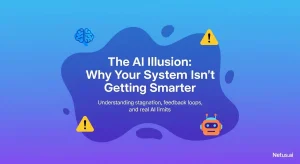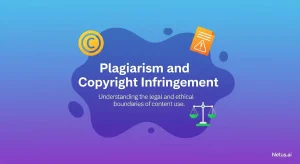Mosaic Plagiarism: Everything You Ought to Know Explained Clearly
Ashley Merit
Content writer and editor for Netus.AI
Table of Contents
Mosaic Plagiarism. Plagiarism, a prevalent issue in the world of writing, manifests itself in various forms. One common type, known as mosaic plagiarism, often appears in academic papers and is primarily committed by students. This form of plagiarism, also referred to as incremental or patchwork plagiarism, can be detrimental to the integrity of one’s work. By understanding its nature and consequences, individuals can take steps to avoid it when crafting their own academic or professional pieces.
In order to prevent mosaic plagiarism, it’s critical to learn about the different types of plagiarism and how to properly paraphrase and cite sources. This knowledge is invaluable for students, teachers, and professionals alike who wish to maintain the integrity of their written work and respect intellectual property rights.
Key Takeaways
- Mosaic plagiarism is a common form often found in academic writing.
- Students are typically the main perpetrators of this type of plagiarism.
- Understanding its consequences and how to avoid it is crucial for maintaining the integrity of one’s work.
What is Mosaic Plagiarism?
Mosaic plagiarism refers to the act of borrowing specific words or phrases from a source without properly quoting or citing them. This type of plagiarism, also known as patchwork plagiarism or patch writing, involves copying content from various sources and joining them together, often with little or no alteration. It might include minor changes and rephrasing of sentences but retains most of the original wording and structure.
When writers use material from other sources, using quotation marks is crucial in order to avoid committing mosaic plagiarism. Also, properly acknowledging the source of borrowed material is key in maintaining academic integrity and avoiding accusations of plagiarism.
In some cases, mosaic plagiarism can be a form of incremental plagiarism, which refers to including passages, excerpts, or quotes without attribution. This occurs when the overall work is original, but specific parts, such as quotations and other data, are used without properly attributing the original source.
Mosaic plagiarism arises when a writer fails to give appropriate credit to the original source of borrowed material. Regardless of whether it’s intentional or accidental, plagiarism is considered academically dishonest and can result in serious consequences.
To avoid mosaic plagiarism, it is essential for authors, especially students and freelance writers, to properly quote and cite borrowed content and ensure they give due credit to the original sources. While conducting research, being cautious and mindful of how source material is incorporated into one’s own work is crucial in maintaining an ethical approach to scholarship and original content creation.
In summary, mosaic plagiarism can occur through the direct copying of phrases or passages without proper attribution, or by piecing together content from multiple sources with minimal alteration. Ensuring appropriate citation and paraphrasing can help prevent this form of plagiarism and maintain the integrity of one’s work.
What Are the Primary Forms of Mosaic Plagiarism?
Mosaic plagiarism takes on two main forms, both of which involve borrowing ideas and phrases from either a single source or multiple sources without proper credit or citation.
1. Patchwork Plagiarism from a Single Source
In this form, students borrow text, sentences, or paragraphs from a single source. They may copy text verbatim or slightly rephrase it, but still present the original author’s ideas as their own work without crediting the source or obtaining permission.
2. Patchwriting Plagiarism from Multiple Sources
This more complex type occurs when students borrow text and ideas from several different sources. They may weave together phrases or sentences from various sources, creating a seemingly cohesive flow without citing the origins of the content.
In both cases, the difference between paraphrasing plagiarism and mosaic plagiarism lies in the level of rephrasing and crediting source materials. While paraphrasing involves completely rewriting an idea in the student’s words, mosaic plagiarism retains much of the original sentence structure and phrasing without proper citation.
Advanced plagiarism checkers, such as Copyleaks, can help detect these forms of mosaic plagiarism, ensuring academic integrity and promoting responsible research and writing.
The Plausible Consequences of Mosaic Plagiarism
Academic Dishonesty and Its Repercussions
Mosaic plagiarism leads to accusations of dishonesty, subsequently resulting in myriad consequences. In schools, this can include reduced grades or even suspension. Upholding academic integrity is essential, as plagiarism undermines the values of respect and integrity in educational institutions.
Bloggers and Reputation Damage
For bloggers, mosaic plagiarism can diminish search engine rankings, which has detrimental effects on their online presence. Moreover, it tarnishes the reputation of individuals involved in such practices. Therefore, it is essential to use a reliable plagiarism checker to ensure original content.
Legal Ramifications
In some cases, authors may seek legal recourse against those who have committed mosaic plagiarism. This could lead to penalties or fines for the offender, further emphasizing the importance of avoiding such practices using tools like Turnitin to maintain integrity in all written work.
How to Prevent Mosaic Plagiarism?
To prevent mosaic plagiarism, follow these best practices:
- Use quotation marks when directly quoting a source
- Always provide proper citations and attributions for borrowed ideas
- Utilize synonyms and rephrase sentences to convey the information in your own words
- Include footnotes in your work to cite sources, when necessary
- Adhere to the specific citation style required for your work
- Make a conscious effort to create unique content while giving credit to the original author
- Regularly check for plagiarism using reliable tools
What Are the Various Types of Plagiarism?
Plagiarism can manifest in several ways, and it’s crucial to recognize the different types to avoid committing this offense. This article will focus on five common forms of plagiarism:
- Global Plagiarism: Occurs when an individual claims an entire work as their own, essentially stealing the authorship from the original creator.
- Paraphrasing Plagiarism: This type of plagiarism involves rewording the original text without properly citing the source. Even though you may have rephrased the content, you still need to credit the original author for their ideas.
- Direct Plagiarism: Involves copying phrases or paragraphs straight from the source without making any alterations to the content.
- Self-Plagiarism: Occurs when one reuses their previously published work, for which they have already received credit. Reusing your own content without proper disclosure can also be considered plagiarism.
- Accidental Plagiarism: Although unintentional, this type of plagiarism occurs when one fails to provide the necessary information in their source citation or makes mistakes while paraphrasing or quoting.
By understanding the various types of plagiarism, individuals can take the necessary steps to ensure that their work maintains its integrity and adheres to the ethical standards of intellectual property.
How to Prevent Mosaic Plagiarism?
To effectively avoid mosaic plagiarism, implement these strategies:
- Familiarize yourself with different types of plagiarism and their consequences.
- Enhance your writing process by developing originality.
- Use direct quotes accurately, and maintain the author’s tone when paraphrasing.
- Always cite verbatim phrases or exact words taken from sources.
- Know what information is considered common knowledge, which does not require citation.
- Adopt patchwriting techniques to ensure an appropriate blend of original and sourced content.
- Follow guidelines to recognize and prevent plagiarism throughout the writing process.
Conclusion
Taking careful steps is vital to prevent mosaic plagiarism. Appropriate citation of sources and honing academic skills can limit the reliance on others’ work and minimize the risks of committing this type of plagiarism. An efficient plagiarism checker is also a useful tool in understanding various kinds of plagiarism and avoiding them in your writing.
Frequently Asked Questions:
Is mosaic plagiarism detrimental?
Indeed, all forms of plagiarism are unethical. Mosaic plagiarism is viewed as intentional and improper in academia, as it uses complete texts from other sources and presents them as one’s own original work.
What are the main features of mosaic plagiarism?
Two primary characteristics of mosaic plagiarism are borrowing words and phrases from multiple sources without proper citation and replacing words without altering the overall structure.
How does paraphrasing plagiarism differ from mosaic plagiarism?
Paraphrasing requires rewriting sentences in your own words while maintaining the original idea from the source. Failing to cite the source while paraphrasing may lead to plagiarism. Mosaic plagiarism occurs when someone copies exact words and phrases from one or more sources without giving credit to the original author.
Frequently Asked Questions
What is considered mosaic plagiarism in scholarly writing?
Mosaic plagiarism, also known as patchwriting, occurs when an individual combines words, phrases, and ideas from multiple sources without proper citation or attribution. This type of plagiarism is often accidental but can be easily avoided by understanding proper paraphrasing and citation techniques.
How can mosaic plagiarism be identified in a text?
Mosaic plagiarism can be detected using plagiarism detection software or by carefully examining the text for inconsistencies in writing style, vocabulary, and phrasing. Comparing the document to its sources can also help identify instances of mosaic plagiarism.
What are the potential outcomes of engaging in mosaic plagiarism?
Committing mosaic plagiarism can result in various consequences, including damage to one’s academic or professional reputation, loss of credit for the work in question, or even disciplinary actions such as suspension or expulsion from a program or institution.
How does mosaic plagiarism differ from direct plagiarism?
While direct plagiarism involves copying an entire passage or work verbatim without attributing the original author, mosaic plagiarism occurs when a writer integrates parts of multiple sources into their writing without proper citations. Direct plagiarism is usually a more blatant act of academic dishonesty, whereas mosaic plagiarism can happen unintentionally.
What methods can be used to prevent mosaic plagiarism?
To avoid mosaic plagiarism:
- Understand proper citation practices: Become familiar with the citation style required by your academic program or institution.
- Practice paraphrasing: Learn how to effectively rephrase content while maintaining the original meaning.
- Quote when necessary: Use quotation marks when including verbatim text from a source.
- Use plagiarism detection tools: Utilize available software to check for potential instances of plagiarism in your work.
How is self-plagiarism connected to mosaic plagiarism?
Self-plagiarism occurs when a writer reuses their previous work without proper attribution. Mosaic plagiarism can involve self-plagiarism if the writer combines parts of their own past work with new content without adequately citing the original source. Both practices undermine the principle of originality in academic writing and can lead to similar consequences.

The shortcomings of content generated by AI | NetusAI
Discover why fast, high-volume AI content often fails to deliver real results. Learn about the crucial missing feedback loop and how implementing performance tracking can transform your AI content strategy.

The illusion of AI: Your system's intelligence gap | NetusAI
Stop wasting marketing spend! Most AI tools don’t learn from results, causing content stagnation and low engagement. Discover why your generative AI isn’t getting smarter and what system actually learns and optimizes content.

Plagiarism and copyright infringement | NetusAI
Learn the distinct differences between plagiarism and copyright infringement. Understand the ethical and legal implications and get practical strategies for avoiding both academic and creative work with NetusAI.

Tips and strategies for mobile content marketing | NetusAI
Optimized for mobile-first indexing, learn 5 essential strategies to capture attention, enhance engagement and drive leads and sales with your mobile content marketing.

Web content editing guidelines for the AI era | NetusAI
Review web content editing guidelines for the AI era. Learn how to edit AI-generated content, ensure authenticity and optimize for SEO and readability.

Explaining AI pattern recognition | NetusAI
AI pattern recognition enables machines to identify trends for diverse applications, from detecting plagiarism to fraud. Discover its processes, models and real-world benefits.
